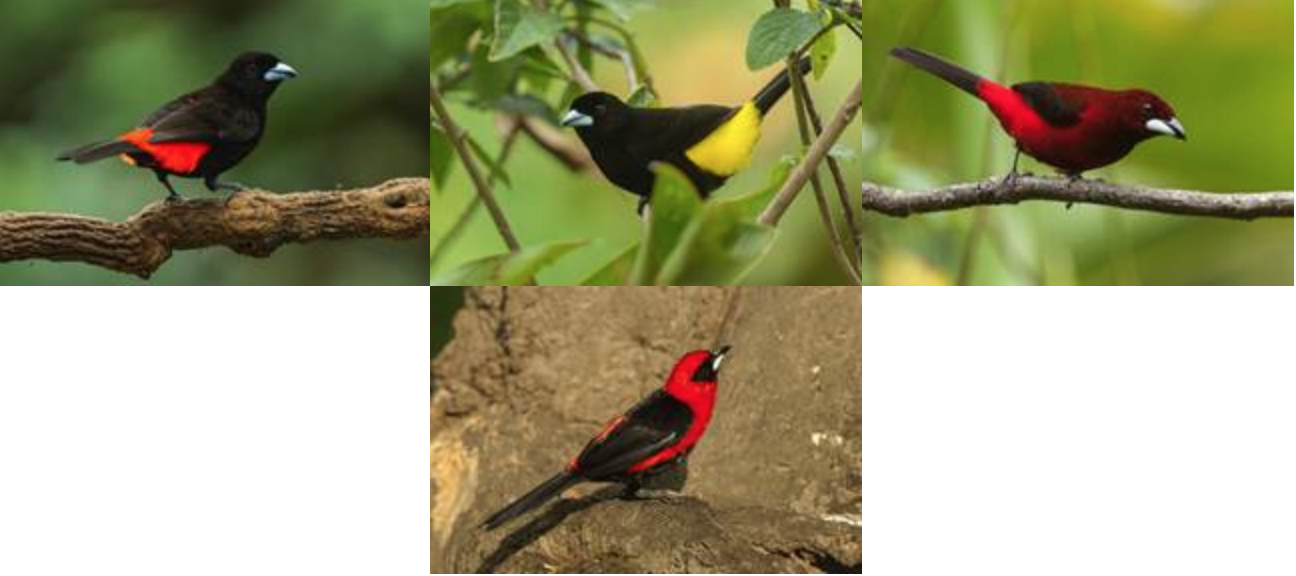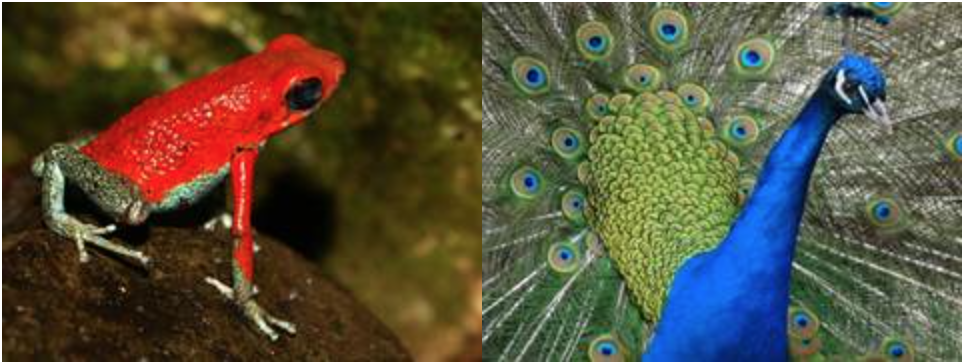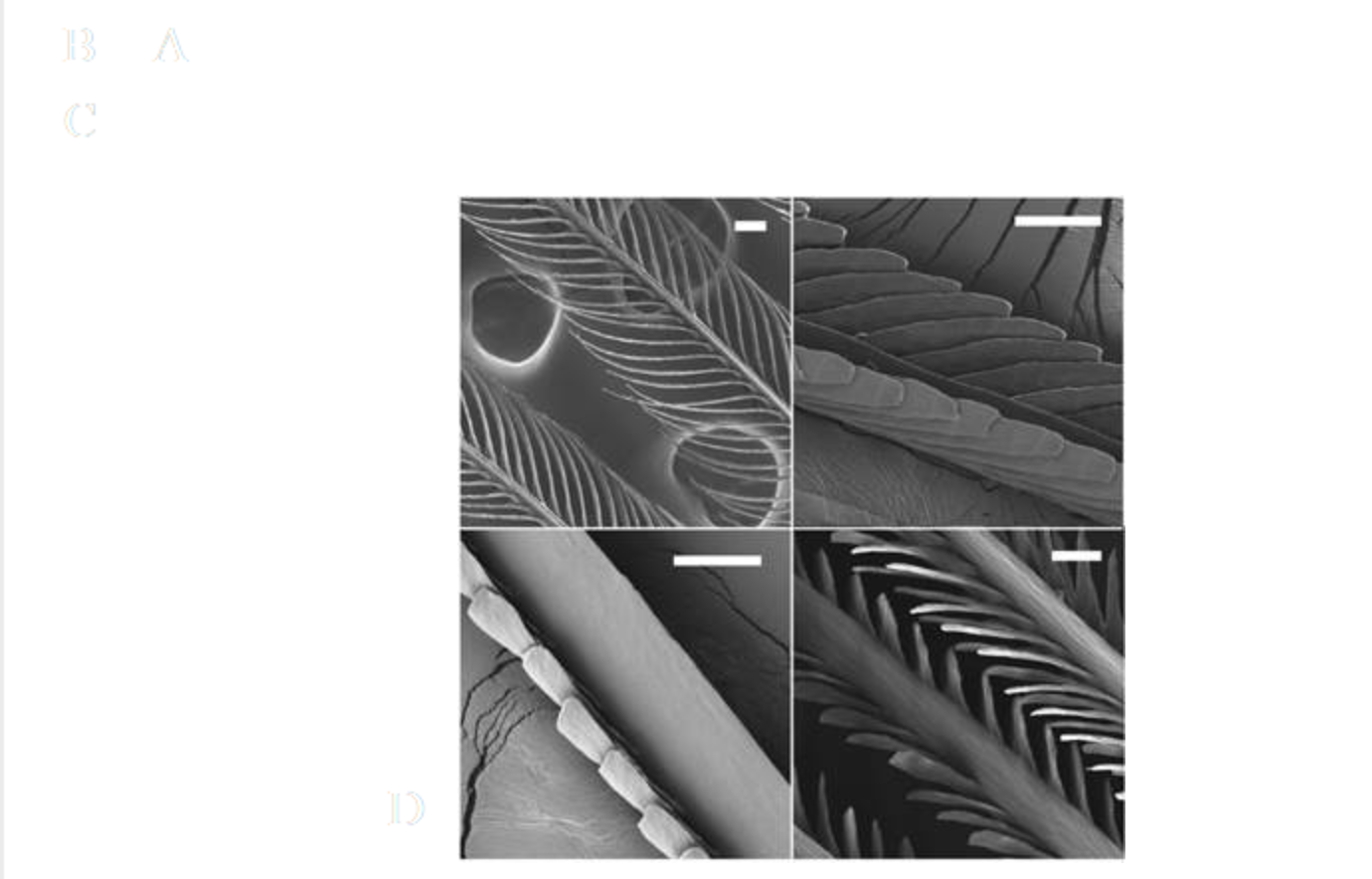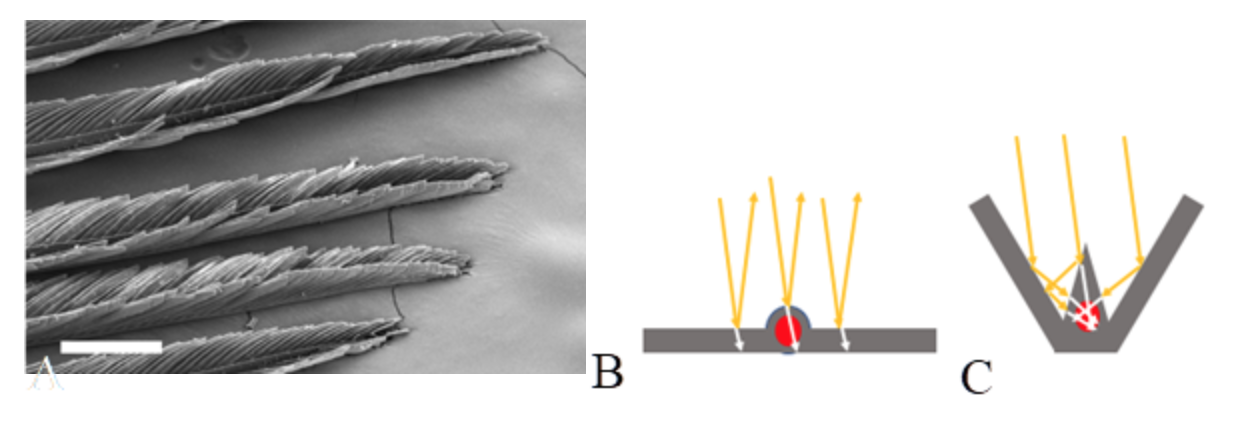By Nicholai M. Hensley
Handling Editor Sharri Zamore
It seems like birds can do it all: they can sing, they can dance, and according to Twitter, they can even play peak-a-boo. In many birds, the brightest, flashiest feathers are expected to adorn the best mates, with showy males trying to attract choosy females. Now, according to new research, we’ve found some species have a different kind of designer flair to accessorize their fanciful feathers. Males in some species of tanagers (genus Rhamphocelus) have gained physical changes to their feathers that make their colors seem brighter and bolder. Harvard graduate student Dakota McCoy’s recent work suggests this haute couture may be a way for male tanagers to enhance their looks, changing ho-hum hues into super colors1.
Tanagers are from a large family of birds (Thraupidae), which has about 380 species that range from small- (4 in.) to medium-sized (11 in.), and that come with a kaleidoscopic palette. Predominantly found in the tropical parts of Central and South America, well-studied members include Darwin’s finches from the Galapagos Islands. But unlike the famously drab birds that enraptured Darwin, tanagers are inordinately colorful. They’ve got some feathers that are abyssal black, arranged spots that are well-paired with patches of colorful feathers: crimson reds, highlighter yellows, or creme soda oranges on different body parts and in different species. Overall the contrasting effect is striking: one little bird with audacious apparel.

Different species of tanagers from the genus Ramphocelus. Males have much brighter, bolder colors and deeper blacks than females of the same species. Each species has a unique kind and combination of these color patches, generating a striking optical effect across their feathers (collectively, called plumage). Pictured are four different species of tanager, with different patterns of colors and black across their plumage. Images under Wikipedia Common License.
Tanagers aren’t the only birds known for having colorful feathers. Some birds have every color under the rainbow flashing on their flanks, like the wildly ornate Birds-of-Paradise, while others pick a palette and play with it in novel ways. After his voyage on the H.M.S. Beagle, Darwin noted these avian accessories seemed most prominent only in male birds. Years later, in his second-most influential work1, Darwin would suggest that this pattern was caused by females being choosy, and whose preferences drove males to develop a chic aesthetic to catch a fickle female’s eye.
From Darwin’s idea came the theory of sexual selection2. Often, in species that have two sexes, one competes for attention or access to the other in order gain a chance at mating. Most often, it’s males who fight for females. There are many strategies, but in birds, males tend to have elaborate shows of courtship to impress females. Over evolutionary time, this has led to a diversity of ornaments and behaviors that are used to attract mates, even if they are costly to maintain. So it behooves males to be the best in show, and that’s where color comes into play.
 Different kinds of colors can indicate different information among animal species. On the left, a granular poison frog uses a bright red back and face to warn would-be predators about the toxins in its skin. While on the right, the peacock uses his array of blue and green tail feathers to try and attract female peahens – a classic example of sexual selection. Images under Wikipedia Common License.
Different kinds of colors can indicate different information among animal species. On the left, a granular poison frog uses a bright red back and face to warn would-be predators about the toxins in its skin. While on the right, the peacock uses his array of blue and green tail feathers to try and attract female peahens – a classic example of sexual selection. Images under Wikipedia Common License.
Color is often used to display information about an individual to others. In some species, color can indicate that the animal is poisonous and shouldn’t be messed with. In others, showy colors are used to attract potential mates. Darker browns and blacks are from pigments made by the body and deposited into skin cells or feathers. Conversely, colors like red and yellow are made with carotenoids that birds cannot make themselves; instead, they have to eat foods that contain carotenoids, absorb them, and then they can be used in feathers and skin. Once metabolized, carotenoid pigments are also used by vertebrate immune systems to stay healthy.
And in order to see these chemical colors, light must interact with the pigments, and then get re-emitted back to our eyes. But physics can be tricky: in reality, when we see a single color, all other colors but that one are being absorbed or scattered by the pigment. The color we perceive is actually what is thrown back from the pigments to our eyes.
So when a female tanager sees red and orange feathers, she’s actually detecting the red and orange light that the pigments of his feathers didn’t absorb. And he should only be able to make these colorful feathers if he has a healthy body. If these colors are only made by “healthy males”, then they should attract more attention from females during mating season over individuals who are duller (and maybe less healthy). Here, color can be called an honest signal of male quality because females can use it to reliably choose the healthiest mate. But over evolutionary time, novel strategies could evolve that disentangle quality from color. In this scenario, the colors traditionally associated with the best mates would become independent from any information about health.
McCoy, along with her colleagues and advisor Dr. David Haig, are testing just how indicative these colors are of mate quality. Using a combination of biochemical and microscopic imaging techniques, they asked whether physical structures of male feathers could explain how tanagers have currant reds and pitch blacks in their plumage. Their studies suggest that these birds are master forgers in a world of pigmented art. Male, and not female, tanagers have evolved a number of feather structures that change how colorful their feathers appear.
When McCoy compared feathers from males and females, she found that they had similar amounts of red and orange pigments in them, but in males, the reds are deeper, and more vibrant. When she looked closer at the feathers, she found microscopic structures, or microstructures adorning their surface. In this case, extra, microscopic spikes on each feather changes the way light interacts with the pigments. As the light bounces off the spikes and around the feather, the color and amount of light reflected back into the eye of the beholder now gives a totally different appearance. These structures enhance the action of the pigments within the feathers, making them more colorful. Like an artist switching from watercolor to oil paints, it seems that just by altering their artistic medium, these birds have been able to change how they create their showy looks with “super colors”.

Using highly sensitive microscopes, McCoy looked at the ends of feathers to see how they differ between males and females. Individual feathers are made up of many barbs protruding off a central support, called a rachis. And each barb itself is made of many barbules protruding off the central structure of the barb. (A) A close-up of feather barbs with barbules of a female tanager. Note their fine, thread-like appearance. (B) – (C) Barbules of male feathers from different species of tanagers. The microstructure, or fine-scale shape of these barbules is very different in male tanagers than in female tanagers or other species of birds. They can be spiky, flat, broad, and even angled. These differences make light interact differently with feathers and their pigments, changing how bold they appear. Images courtesy of Dakota McCoy.
McCoy has shown that these microstructures not only occur on red and orange feathers, but with black as well. Using the same spiky surface, some dark feathers on males now appear jet black, as if staring into a dark forest at night. Unlike a crow or raven, whose iridescent, black feathers seem to glimmer and have highlights, the feathers of tanagers are so dark that they can be hard to focus on. Now, the visible light that hits a feather barely bounces back at all, making them “super black”.

(A) A close-up of the feather microstructures shows the characteristic V-shaped angles that the barbules make, as opposed to lying flat. (B) Light that strikes feathers (yellow lines) without barbule microstructures will exit without interacting with the underlying pigment (red dot) as much, and therefore seem less vibrant. (C) In colorful feathers, the shape and angle of these microstructures change how light (yellow lines) interacts with the pigments at the base of the barbules (white lines with the red dot), making the exiting light seem richer and brighter than pigment alone. In super black feathers, the microstructures trap light by bouncing it back and forth among the barbules, allowing only some to come back out of the feathers and to be seen. Images courtesy of Dakota McCoy.
But the story isn’t over yet. Independently, super black feathers and oversaturated reds don’t necessarily make tanagers deceptive. McCoy and her colleagues think the real treat comes from the marriage of these two super color changes. Along with these feather structures, tanagers juxtapose saturated red and super black feathers to create plumage of astonishingly high contrast. A sight to behold indeed, and it’s this contrast that completes the male’s illusion.
Previous work by other researchers has examined how vertebrates like tanagers see and concludes that strong contrast can create visual illusions3,4,5. See, vertebrate eyes have the rather useful tendency to try and keep colors the same across conditions. Despite how it appears, objects can have very different amounts of light reflected off them. You can imagine that a sunny afternoon in a field might be much brighter than the darkened floor of a tropical forest. In these cases, the amount of red light bouncing around is very different, and yet our brains can see red as pretty similar either way. This is because our visual systems have evolved the habit of trying to correct for such crazy lighting. Our perception does this by comparing the amount of light coming back from an object to the amount of light coming from its local surroundings, allowing vertebrates to have color constancy.

A classic visual illusion that occurs because of color constancy. In (A), the tiles labeled A and B reside next to a tall cylinder, one in its shadow and one outside it. Tile A appears darker to us. (B) If you connect these tiles and remove the gradient of lighting caused by the shadow, we can tell that tiles A and B are actually the same color. The added bar removes the local contrast provided by the shadow’s gradient. (C) Because male tanagers have microstructures that create super black and remove shimmery highlights, colorful plumage next to them appear enhanced because we cannot establish any local contrast around the color. Images under Wikipedia Common License.
But how would this make male tanagers pop with color? Well their super black feathers lack highlights, which usually provide a visual scene with contrast. When paired with the super colorful reds and yellows, female tanagers cannot correct for the amount of returning light. This makes the bright plumage, already enhanced with microstructural modifications, appear even more vibrant. The illusion is complete, and male tanagers seem to dazzle with their varying hues.
Microstructural changes that produce super black—like the additional barbules on male tanager feathers—have been found in other animals like butterflies as well, albeit done in a slightly different way. But this may be the first evidence that super black and other structural colors are due to an evolutionary arms race between males and females: males find new ways to appear healthy, and females find new ways to measure health. McCoy suggests that when evolutionary games place pressure on signals, such as color, in order to convey quality, the system is ripe for cheaters.
With the advent of super colors, male quality and color could become separated over many generations. But given her team’s research, she doesn’t believe that male tanagers are intentionally deceiving females. In fact, McCoy makes no claims about how or why these microstructures originally evolved. Regardless, once they evolved, these structures allowed the game to be subverted, and those with microstructures gained the upper hand. With the tanagers, it seems like males evolved novel feather features that can exploit the perceptual abilities of females; suddenly, reds and oranges that may be truly indicative of health in other bird species no longer contain any useful information for female tanagers to choose upon. However, more work needs to be done to see if females pay attention to these super colors, and how that might allow both healthy and unhealthy males to attract mates.
McCoy and colleagues have provided a new, exciting example of changes in physical structures influencing their function. Microstructures that increase color richness have potential applications in engineering and other applied disciplines, from more vibrant paint colors to better solar cells. At least in evolutionary terms, it seems that deceptive tanagers have found a way to make the ordinary a little more beautiful. McCoy and her colleagues reported these findings at the annual Society of Integrative and Comparative Biology, held in Tampa, Florida this past January.
- Mccoy, D.E., Shultz, A.J., Vidoudez, C., Van der Heide, E., Trauger, S.A. and Haig, D., 2019, March. The Corruption of Honest Signals: from Mate Choice in Red Birds to Human Pregnancy. In INTEGRATIVE AND COMPARATIVE BIOLOGY(Vol. 59, pp. E152-E152). JOURNALS DEPT, 2001 EVANS RD, CARY, NC 27513 USA: OXFORD UNIV PRESS INC.
- Darwin, C., 1896. The descent of man and selection in relation to sex (Vol. 1). D. Appleton.
- Brainard, D.H., Wandell, B.A. and Chichilnisky, E.J., 1993. Color constancy: from physics to appearance. Current Directions in Psychological Science, 2(5), pp.165-170.
- Speigle, J.M. and Brainard, D.H., 1996. Luminosity thresholds: Effects of test chromaticity and ambient illumination. JOSA A, 13(3), pp.436-451.
- Hurlbert, A., 2007. Colour constancy. Current Biology, 17(21), pp.R906-R907.

